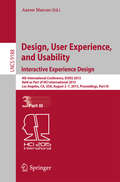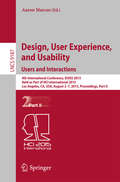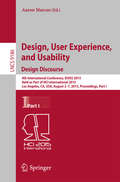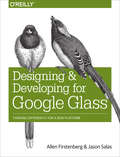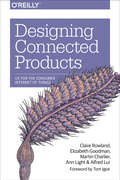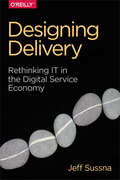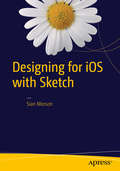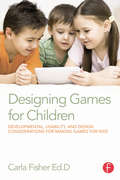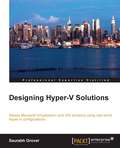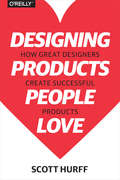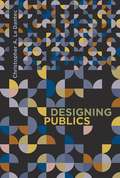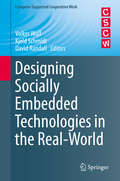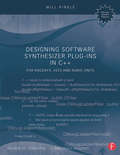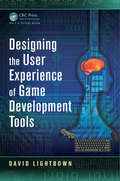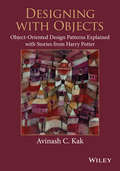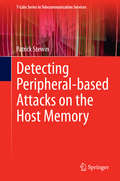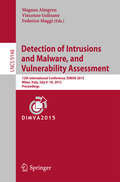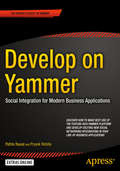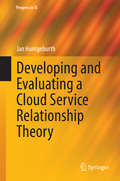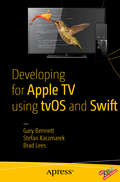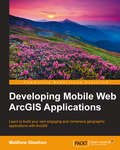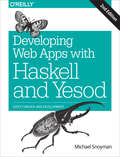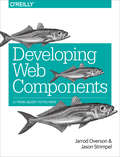- Table View
- List View
Design, User Experience, and Usability: Interactive Experience Design
by Aaron MarcusThe three-volume set LNCS 9186, 9187, and 9188 constitutes the proceedings of the 4th International Conference on Design, User Experience, and Usability, DUXU 2015, held as part of the 17th International Conference on Human-Computer Interaction, HCII 2015, in Los Angeles, CA, USA, in August 2015, jointly with 13 other thematically similar conferences. The total of 1462 papers and 246 posters presented at the HCII 2015 conferences were carefully reviewed and selected from 4843 submissions. These papers address the latest research and development efforts and highlight the human aspects of design and use of computing systems. The papers accepted for presentation thoroughly cover the entire field of Human-Computer Interaction, addressing major advances in knowledge and effective use of computers in a variety of application areas. The total of 132 contributions included in the DUXU proceedings were carefully reviewed and selected for inclusion in this three-volume set. The 64 papers included in this volume are organized in topical sections on designing the social media experience, designing the learning experience, designing the playing experience, designing the urban experience, designing the driving experience, designing the healthcare patient's experience, and designing for the healthcare professional's experience.
Design, User Experience, and Usability: Users and Interactions
by Aaron MarcusThe three-volume set LNCS 9186, 9187, and 9188 constitutes the proceedings of the 4th International Conference on Design, User Experience, and Usability, DUXU 2015, held as part of the 17th International Conference on Human-Computer Interaction, HCII 2015, in Los Angeles, CA, USA, in August 2015, jointly with 13 other thematically similar conferences. The total of 1462 papers and 246 posters presented at the HCII 2015 conferences were carefully reviewed and selected from 4843 submissions. These papers address the latest research and development efforts and highlight the human aspects of design and use of computing systems. The papers accepted for presentation thoroughly cover the entire field of Human-Computer Interaction, addressing major advances in knowledge and effective use of computers in a variety of application areas. The total of 132 contributions included in the DUXU proceedings were carefully reviewed and selected for inclusion in this three-volume set. The 67 papers included in this volume are organized in topical sections on users in DUXU, women in DUXU, information design, touch and gesture DUXU, mobile DUXU, and wearable DUXU.
Design, User Experience, and Usability: 4th International Conference, DUXU 2015, Held as Part of HCI International 2015, Los Angeles, CA, USA, August 2-7, 2015, Proceedings, Part I (Lecture Notes in Computer Science #9186)
by Aaron MarcusThe three-volume set LNCS 9186, 9187, and 9188 constitutes the proceedings of the 4th International Conference on Design, User Experience, and Usability, DUXU 2015, held as part of the 17th International Conference on Human-Computer Interaction, HCII 2015, in Los Angeles, CA, USA, in August 2015, jointly with 13 other thematically similar conferences. The total of 1462 papers and 246 posters presented at the HCII 2015 conferences were carefully reviewed and selected from 4843 submissions. These papers address the latest research and development efforts and highlight the human aspects of design and use of computing systems. The papers accepted for presentation thoroughly cover the entire field of Human-Computer Interaction, addressing major advances in knowledge and effective use of computers in a variety of application areas. The total of 132 contributions included in the DUXU proceedings were carefully reviewed and selected for inclusion in this three-volume set. The 61 papers included in this volume are organized in topical sections on design thinking, user experience design and usability methods and tools, DUXU management and practice, emotional and persuasion design, and storytelling, narrative and fiction in DUXU.
Designing and Developing for Google Glass
by Jason Salas Allen FirstenbergCreating apps for Google Glass is more involved than simply learning how to navigate its hardware, APIs, and SDK. You also need the right mindset. While this practical book delivers the information and techniques you need to build and deploy Glass applications, it also helps you to think for Glass by showing you how the platform works in, and affects, its environment.In three parts--Discover, Design, and Develop--Glass pioneers guide you through the Glass ecosystem and demonstrate what this wearable computer means for users, developers, and society as a whole. You'll learn how to create rich functionality for a consumer technology that's radically different than anything currently available.Learn the Five Noble Truths of great Glassware designUnderstand the Glass ecosystem and learn why it's differentSidestep Glass's societal concerns in your projectsLearn how Glass adapts to the user's world, rather than the other way aroundAvoid poor design by identifying Glassware antipatternsBuild cloud services with the Google Mirror APIUse the Glass Development Kit to develop client applicationsSubmit your project for review in the MyGlass directory
Designing Connected Products: UX for the Consumer Internet of Things
by Elizabeth Goodman Claire Rowland Martin Charlier Ann Light Alfred LuiNetworked thermostats, fitness monitors, and door locks show that the Internet of Things can (and will) enable new ways for people to interact with the world around them. But designing connected products for consumers brings new challenges beyond conventional software UI and interaction design.This book provides experienced UX designers and technologists with a clear and practical roadmap for approaching consumer product strategy and design in this novel market. By drawing on the best of current design practice and academic research, Designing Connected Products delivers sound advice for working with cross-device interactions and the complex ecosystems inherent in IoT technology.
Designing Delivery
by Jeff SussnaNow that we're moving from a product economy to a digital service economy, software is becoming critical for navigating our everyday lives. The quality of your service depends on how well it helps customers accomplish goals and satisfy needs. Service quality is not about designing capabilities, but about making--and keeping--promises to customers.To help you improve customer satisfaction and create positive brand experiences, this pragmatic book introduces a transdisciplinary approach to digital service delivery. Designing a resilient service today requires a unified effort across front-office and back-office functions and technical and business perspectives. You'll learn how make IT a full partner in the ongoing conversations you have with your customers.Take a unique customer-centered approach to the entire service delivery lifecycleApply this perspective across development, operations, QA, design, project management, and marketingImplement a specific quality assurance methodology that unifies those disciplinesUse the methodology to achieve true resilience, not just stability
Designing for iOS with Sketch
by Sian MorsonDesigning for iOS with Sketch takes you through the process of designing your iOS app using Bohemian Code's Sketch. Sketch is a powerful new design program that is quickly replacing Adobe PhotoShop for many designers designing for mobile apps and the mobile web. This book will introduce you to the program and then take you through the steps of designing your very own app. It includes examples and shortcuts as well as a helpful list of plugins and 3rd party resources that will greatly improve your workflow. What you'll learn What sets Sketch apart from PhotoShop and Illustrator Use Sketch to design a simple iOS app Learn helpful shortcuts to speed up your workflow Get a helpful list of resources from around the web Includes a list of plugins to extend Sketch and make designing more fun Who this book is for Beginning to intermediate iOS app designers who are looking for an alternative to PhotoShop. Table of Contents Chapter 1: Why Sketch? Chapter 2: The Sketch Interface Chapter 3: Shapes and Styles Chapter 4: Symbols Chapter 5: Text and Fonts Chapter 6: Optimizing Your Workflow Chapter 7: Creating a Simple App Chapter 8: Creating an Icon Chapter 9: Exporting Assets for Development Chapter 10: Sketch Resources and Plugins
Designing Games for Children: Developmental, Usability, and Design Considerations for Making Games for Kids
by Carla FisherWhen making games for kids, it’s tempting to simply wing-it on the design. We were all children once, right? The reality is that adults are far removed from the cognitive changes and the motor skill challenges that are the hallmark of the developing child. Designing Games for Children, helps you understand these developmental needs of children and how to effectively apply them to games. <P><P> Whether you’re a seasoned game designer, a children's media professional, or an instructor teaching the next generation of game designers, Designing Games for Children is the first book dedicated to service the specific needs of children's game designers. This is a hands-on manual of child psychology as it relates to game design and the common challenges designers face. <P><P> Designing Games for Children is the definitive, comprehensive guide to making great games for kids, featuring: <li> Guidelines and recommendations divided by the most common target audiences – babies and toddlers (0-2), preschoolers (3-5), early elementary students (6-8), and tweens (9-12). <li> Approachable and actionable breakdown of child developmental psychology, including cognitive, physical, social, and emotional development, as it applies to game design <li> Game design insights and guidelines for all aspects of game production, from ideation to marketing
Designing Hyper-V Solutions
by Saurabh GroverThis book is aimed at IT admins, consultants, and architects alike who wish to deploy, manage, and maintain Hyper-V solutions in organizations of various sizes. You are expected to have a working knowledge of managing Windows Server and a fair understanding of networking and storage concepts.
Designing Products People Love
by Scott HurffHow can you create products that successfully find customers? With this practical book, you'll learn from some of the best product designers in the field, from companies like Facebook and LinkedIn to up-and-coming contenders. You'll understand how to discover and interpret customer pain, and learn how to use this research to guide your team through each step of product creation.Written for designers, product managers, and others who want to communicate better with designers, this book is essential reading for anyone who contributes to the product creation process.Understand exactly who your customers are, what they want, and how to build products that make them happyLearn frameworks and principles that successful product designers useIncorporate five states into every screen of your interface to improve conversions and reduce perceived loading timesDiscover meeting techniques that Apple, Amazon, and LinkedIn use to help teams solve the right problems and make decisions fasterDesign effective interfaces across different form factors by understanding how people hold devices and complete tasksLearn how successful designers create working prototypes that capture essential customer feedbackCreate habit-forming and emotionally engaging experiences, using the latest psychological research
Designing Publics
by Christopher A. Le DantecContemporary computing technologies have thoroughly embedded themselves in every aspect of modern life -- conducting commerce, maintaining and extending our networks of friends, and mobilizing political movements all occur through a growing collection of devices and services designed to keep and hold our attention. Yet what happens when our attention needs to be more local, collective, and focused on our immediate communities? Perhaps more important, how can we imagine and create new technologies with local communities? In Designing Publics, Christopher Le Dantec explores these questions by designing technologies with the urban homeless. Drawing on a case study of the design of a computational infrastructure in a shelter for homeless women and their children, Le Dantec theorizes an alternate vision of design in community contexts.Focusing on collective action through design, Le Dantec investigates the way design can draw people together on social issues and create and sustain a public. By "designing publics" he refers both to the way publics arise out of design intervention and to the generative action publics take -- how they "do design" as they mobilize and act in the world. This double lens offers a new view of how design and a diverse set of design practices circulate in sites of collective action rather than commercial production.
Designing Socially Embedded Technologies in the Real-World
by Volker Wulf Kjeld Schmidt David RandallThis book is concerned with the associated issues between the differing paradigms of academic and organizational computing infrastructures. Driven by the increasing impact Information Communication Technology (ICT) has on our working and social lives, researchers within the Computer Supported Cooperative Work (CSCW) field try and find ways to situate new hardware and software in rapidly changing socio-digital ecologies. Adopting a design-orientated research perspective, researchers from the European Society for Socially Embedded Technologies (EUSSET) elaborate on the challenges and opportunities we face through the increasing permeation of society by ICT from commercial, academic, design and organizational perspectives. Designing Socially Embedded Technologies in the Real-World is directed at researchers, industry practitioners and will be of great interest to any other societal actors who are involved with the design of IT systems.
Designing Software Synthesizer Plug-Ins in C++: For RackAFX, VST3, and Audio Units
by Will PirkleBridging the gap from theory to programming, Designing Software Synthesizer Plug-Ins in C++ For RackAFX, VST3 and Audio Units contains complete code for designing and implementing software synthesizers for both Windows and Mac platforms. You will learn synthesizer operation, starting with the underlying theory of each synthesizer component, and moving on to the theory of how these components combine to form fully working musical instruments that function on a variety of target digital audio workstations (DAWs). Containing some of the latest advances in theory and algorithm development, this book contains information that has never been published in textbook form, including several unique algorithms of the author’s own design. The book is broken into three parts: plug-in programming, theory and design of the central synthesizer components of oscillators, envelope generators, and filters, and the design and implementation of six complete polyphonic software synthesizer musical instruments, which can be played in real time. The instruments implement advanced concepts including a user-programmable modulation matrix. The final chapter shows you the theory and code for a suite of delay effects to augment your synthesizers, introducing you to audio effect processing. The companion website, www.focalpress.com/cw/pirkle, gives you access to free software to guide you through the application of concepts discussed in the book, and code for both Windows and Mac platforms. In addition to the software, it features bonus projects, application notes, and video tutorials. A reader forum, monitored by the author, gives you the opportunity for questions and information exchange.
Designing the User Experience of Game Development Tools
by David LightbownMost tools developers want to improve the user experience but are not given the time, lack the techniques, or don't know where to begin.Designing the User Experience of Game Development Tools addresses these issues to empower tools developers to make positive steps toward improving the user experience of their tools.The book explains how to im
Designing with Objects
by Avinash C. Kak* All code examples in the book are available for download on a companion site with resources for readers and instructors* A refreshing alternative to the rather abstract and dry explanations of the object-oriented design patterns in much of the existing literature on the subject* In 24 chapters, Designing with Objects explains well-known design patterns by relating them to stories from the Harry Potter series
Detecting Peripheral-based Attacks on the Host Memory
by Patrick StewinThis work addresses stealthy peripheral-based attacks on host computers and presents a new approach to detecting them. Peripherals can be regarded as separate systems that have a dedicated processor and dedicated runtime memory to handle their tasks. The book addresses the problem that peripherals generally communicate with the host via the host's main memory, storing cryptographic keys, passwords, opened files and other sensitive data in the process - an aspect attackers are quick to exploit. Here, stealthy malicious software based on isolated micro-controllers is implemented to conduct an attack analysis, the results of which provide the basis for developing a novel runtime detector. The detector reveals stealthy peripheral-based attacks on the host's main memory by exploiting certain hardware properties, while a permanent and resource-efficient measurement strategy ensures that the detector is also capable of detecting transient attacks, which can otherwise succeed when the applied strategy only measures intermittently. Attackers exploit this strategy by attacking the system in between two measurements and erasing all traces of the attack before the system is measured again.
Detection of Intrusions and Malware, and Vulnerability Assessment
by Magnus Almgren Vincenzo Gulisano Federico MaggiThis book constitutes the refereed proceedings of the 12th International Conference on Detection of Intrusions and Malware, and Vulnerability Assessment, DIMVA 2015, held in Milan, Italy, in July 2015. The 17 revised full papers presented were carefully reviewed and selected from 75 submissions. The papers are organized in topical sections on attacks, attack detection, binary analysis and mobile malware protection, social networks and large-scale attacks, Web and mobile security, and provenance and data sharing.
Deterring Cyber Warfare: Bolstering Strategic Stability in Cyberspace
by Brian M. Mazanec Bradley A. ThayerWhile the deterrence of cyber attacks is one of the most important issues facing the United States and other nations, the application of deterrence theory to the cyber realm is problematic. This study introduces cyber warfare and reviews the challenges associated with deterring cyber attacks, offering key recommendations to aid the deterrence of major cyber attacks.
Develop on Yammer
by Pathik Rawal Pryank RohillaDevelop on Yammer is your guide to integrating the Yammer social network with your company's application ecosystem. By developing custom apps and features on the Yammer platform, you can make your workplace more productive, encourage communication and feedback, and get your colleagues collaborating across a range of platforms, including SharePoint, ASP. NET, and Windows Phone. The book begins with an introduction to the development options available along with guidance on how to set up a Yammer developer account. You'll then take your first step in Yammer integration by building a Yammer feed into a web page or other JavaScript-based client application, before diving into app creation and management on the Yammer platform. The authors provide a deep dive into the Yammer authorization process from client-side and server-side perspectives, and you'll find out how to work closely with Yammer's data streams and its full range of development possibilities using Open Graph and Yammer's REST API. The final chapters cover how to build Yammer integration into standalone applications for SharePoint and Windows Phone 8 with Yammer SDKs. All chapters are illustrated with examples and sample code, and a case study follows the development of a workplace training application as the authors apply each technique, so you can see how to make the most of what Yammer has to offer. What you'll learn Why develop on Yammer, and what development options are available How to add a Yammer feed to an HTML-based application using Yammer Embed, to bring relevant news and discussions into the contexts where they matter How to develop custom Yammer features for your SharePoint, Office or web applications on the client side with the Yammer JavaScript SDK How to carry out secure authorization and authentication on Yammer How to use Yammer Open Graph and REST APIs to posts messages, create custom activities and get data from Yammer-integrated applications How to work with the Yammer Windows Phone 8 SDK to add Yammer functionality to a Windows Phone 8 application Who this book is for This book is targeted at developers with a background in . NET/C# development. Readers should be comfortable working with JavaScript. Software architects will also find this book valuable for planning social integration across their companies' business ecosystems. Table of Contents Chapter 1: Introduction to Yammer Development Chapter 2: Yammer Feed Integration with Yammer Embed Chapter 3: Yammer App Development Basics Chapter 4: Authenticating Your Yammer Users Chapter 5: Writing Data into Yammer with Open Graph Chapter 6: Developing Custom Integrations with the Yammer REST API Chapter 7: Build Social Apps Using Yammer's JavaScript SDK Chapter 8: Build Social Apps Using Yammer's Windows Phone 8 SDK
Developing and Evaluating a Cloud Service Relationship Theory
by Jan HuntgeburthThis book develops, evaluates and refines a cloud service relationship theory that explains how cloud users' uncertainties arise in these relationships and how they can be mitigated. To that end, the book employs principal-agent theory and the concepts of bounded rationality and social embeddedness. Beyond advancing IS research, the findings presented can greatly benefit governments, IT departments and IT providers, helping them to better understand cloud service relationships and to adjust their cloud service strategies accordingly.
Developing for Apple TV using tvOS and Swift
by Gary Bennett Stefan Kaczmarek Brad LeesGary Bennett, Brad Lees, and Stefan Kaczmarek, the team behind Swift 2 for Absolute Beginners, brings you a hands-on "Swift" introduction to the new tvOS SDK with a collection of app projects to try out. You'll learn how to create a BookStore app for the TV, including using Stack Views for book details, how to create a photo gallery app, and how to use collection view and split view controllers with a music collection app. Finally, you'll also learn how to store Apple TV app data in iCloud. The new Apple TV is here, and it's open for your native apps -- Developing for the Apple TV with tvOS and Swift will get you started developing right away. What you'll learn How to use stack views in tvOS How to use collection views and split view controllers How to store Apple TV app data in iCloud How to create native apps for books, photos, and music on the Apple TV Who this book is for Intermediate iOS developers who want to create native Apple TV apps using the new tvOS SDK. Table of Contents Chapter 1: Getting Started with the New Apple TV Chapter 2: The tvOS Weather App Chapter 3: Stack Views and the Focus Engine Chapter 4: Creating a Photo Gallery App Chapter 5: Adding an Album Browser to the Photo Gallery App Chapter 6: Adding a Dynamic Top Shelf to the Photo Gallery App Chapter 7: Storing and Sharing Data Chapter 8: CloudKit
Developing Mobile Web ArcGIS Applications
by Matthew SheehanThis guide is invaluable to those just starting out with GIS development but will also benefit GIS professionals wishing to expand their development skills to include mobile apps.
Developing Online Language Teaching
by Regine HampelWhen moving towards teaching online, teachers are confronted every day with issues such as online moderation, establishing social presence online, transitioning learners to online environments, giving feedback online. This book supports language teaching professionals and researchers who are keen to engage in online teaching and learning.
Developing Web Apps with Haskell and Yesod
by Michael SnoymanThis fast-moving guide introduces web application development with Haskell and Yesod, a potent language/framework combination that supports high-performing applications that are modular, type-safe, and concise. Fully updated for Yesod 1.4, this second edition shows you how Yesod handles widgets, forms, persistence, and RESTful content. Author Michael Snoyman also introduces various Haskell tools to supplement your basic knowledge of the language.By the time you finish this book, you'll create a production-quality web application with Yesod's ready-to-use scaffolding. You'll also examine several real-world examples, including a blog, a wiki, a JSON web service, and a Sphinx search server.Build a simple application to learn Yesod's foundation datatype and Web Application Interface (WAI)Output HTML, CSS, and Javascript with Shakespearean template languagesGet an indepth look at Yesod's core monads for producing cleaner, more modular codeProbe Yesod's internal workings: learn the request handling process for a typical applicationBuild forms on top of widgets by implementing the yesod-form declarative APILearn how Yesod and Haskell handle persistence and session dataServe an HTML page and a machine-friendly JSON page from the same URL
Developing Web Components
by Jason Strimpel Jarrod OversonAlthough web components are still on the bleeding edge--barely supported in modern browsers--the technology is also moving extremely fast. This practical guide gets you up to speed on the concepts underlying W3C's emerging standard and shows you how to build custom, reusable HTML5 Web Components.Regardless of your experience with libraries such as jQuery and Polymer, this book teaches JavaScript developers the DOM manipulations these libraries perform. You'll learn how to build a basic widget with vanilla JavaScript and then convert it into a web component that's semantic, declarative, encapsulated, consumable, and maintainable. With custom components, the Web can finally fulfill its potential as a natively extensible application platform. This book gets you in at the right time.Understand core concepts (such as normal flow and positioning, and Z-index) for properly positioning, dragging, and resizing elementsExplore UI concepts and patterns typically abstracted away by Dojo, jQuery UI, Kendo UI, and other librariesDive into the W3C standard and convert your working widget example into a fully functioning web componentLearn how to encapsulate, package, and deploy your web components with Google's Polymer framework
